Fiat 132GL
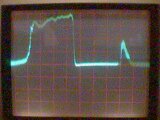

12 Jul 2002: This is a kitset that I have built to install in the Fiat. The Jaycar catalogue number is KC5300. The kit allows you to measure the air:fuel ratio of your engine. I'm going to use it to track down the flat spot in the throttle response when cruising. I think the car might be running slightly lean.
As standard the kitset comes calibrated for a Bosch sensor. After completing the kit I went to buy the sensor. Well it turns out there is more to a sensor than one might first imagine. There are standard (EGO) sensors that are good for measuring around the 14.7:1 ratio. These do not work well with particularly rich or lean mixtures. For such mixtures it is better to use what is known as a wide-band (UEGO) sensor. They exhibit a transfer curve that produces a more accurate result when measuing particularly rich or lean mixtures. The particular sensor this kit is calibrated for is a wide-band sensor. Now the scarey part. The Bosh sensor retails for around NZ$730 (~US$350). This is around ten times the price of the kitset itself. With this in mind I put off buying a sensor at all.
I hooked up a variable voltage display to the input of the kit and took some photos (below). This lets you see the typical values you might see on a working unit. Everything from rich (R) through to Lean (L).
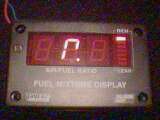
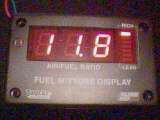
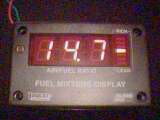
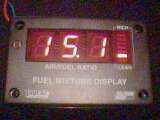
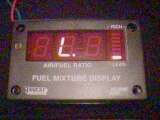
I have been fluffing around and performing a lot of research on the web and locally. The more I look the worse it appears to get. At best, people grab any old sensor, hook it up to a volt meter (preferably digital because of the high impedance of such a meter) and use this with great success in tuning their car. Hooray. At worst, it appears that the sensors are quite variable beasts, and things such as temperature have a major effect on the voltage a sensor will produce. Unless you can measure what temperature your sensor is running at in some dynamic way, your measurements when in the rich area could be a long way off.
OK, I've decided to go with a typical garden variety EGO sensor and to see how it goes. I saw that people on the Net were paying around US$30 for them, so I decided to go to the local parts shop and just buy a new unit. OK, NZ$142 (US$70) later I have a brand new generic single wire EGO sensor. So much for obtaining a cheap sensor. Still it's better than $700+. I decided to take a photo of this wonderful piece of equipment (below).

The next stage is to have the sensor fitted to the car in a suitable location.
Continue to distributor-less ignition